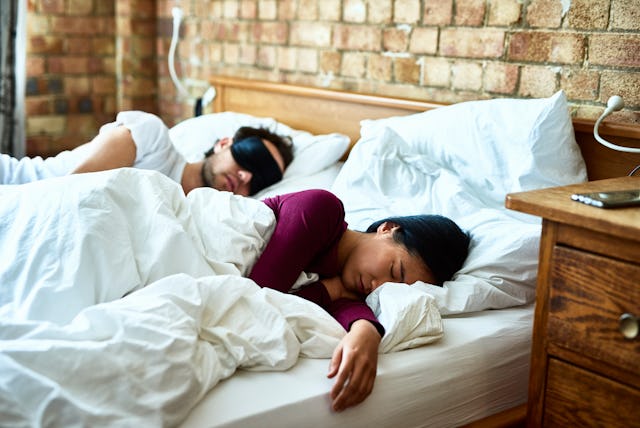The Cold Truth About The Best Temperature For Sleep, From An Expert
If you and your partner disagree on where to set the thermostat, this noted sleep psychologist has what she says is the right temperature for bedtime.

Sleep is every parent's Holy Grail, which is why it's so frustrating when we disagree with our family about what makes an ideal sleep environment. The best temperature for sleep is a hot (ha!) topic in our house because I like it cool, about 65 degrees, but my husband would prefer about 72 degrees. I am happy (OK, smug) to report that a noted sleep expert agrees with me: Cool temperatures are best for sleep.
In fact, sleep psychologist Michelle Drerup, PsyD, of Cleveland Clinic, says to keep your bedroom between 60 to 67° F. Now, 60 degrees is freezing even by my standards. But apparently, cool temps help you achieve ideal REM (dream) sleep. "Thermoregulation is very important for staying in restorative, slow-wave sleep stages," said Drerup. "These are the stages in which we get the most rest."
Try Sleeping at 65 Degrees
I feel vindicated, but science isn't going to make people who naturally run cold, like my husband, change their minds about the room temperature. When my husband travels, he sets his room to 72 degrees and sleeps just fine, or so he thinks. It's not like we've ever tried tracking his REM sleep. Meanwhile, my new best friend Dr. Drerup suggests that we stick to 65 degrees at home.
"The science behind ideal room temperature being around 65 degrees relates to your body's internal temperature regulation for sleep," she says. "Our core body temperature naturally experiences a slight dip in the evening, so turning down the thermostat at night may signal your body that it's time for sleep. Warmer temperatures can cause discomfort and restlessness and not only impact our ability to fall asleep, but also negatively impact sleep quality, including being associated with decreases in restorative slow-wave sleep."
There’s a caveat, though. While cooler temps tend to be conducive to better sleep, you don't want to set the thermostat too cool. "When we're cold, our body kicks into high gear to try and get us warm again," Drerup explained.
Babies Need It to Be a Little Warmer
Babies and toddlers also sleep better in a cool room. But the temp doesn't have to be as low for them. "For infants, you may consider having them sleep in a room a degree or two warmer," Drerup says, which would mean 66 or 67 degrees. "They cannot regulate their temperatures as easily as adults, and they don't sleep with blankets to help decrease the risk of SIDS."
Many baby monitors will read the room temperature. And this is all a good reminder not to over-bundle your baby. If they are in footed pajamas and swaddled, they're likely to get too hot and end up restless and overheated. Try just a onesie with the swaddle. Then, a tip from the Cleveland Clinic: Touch the back of their neck. If their skin is sweaty, remove a layer or decrease the temperature of the room a bit.
Kids May Do Well To Stay Cool, Too
Once you have preschool-age kids, try the 65-degree tip and see if it keeps them under the covers and conked out. The Cleveland Clinic also suggests trying a fan in the room for cooling, with the added benefit of some white noise. Hey, this is an easy tip worth trying! Though it does intimidate me a bit, thinking of the potential summer air-conditioning and electric bills. But if there's one thing I'm willing to pay for, it's good sleep!
This article was originally published on